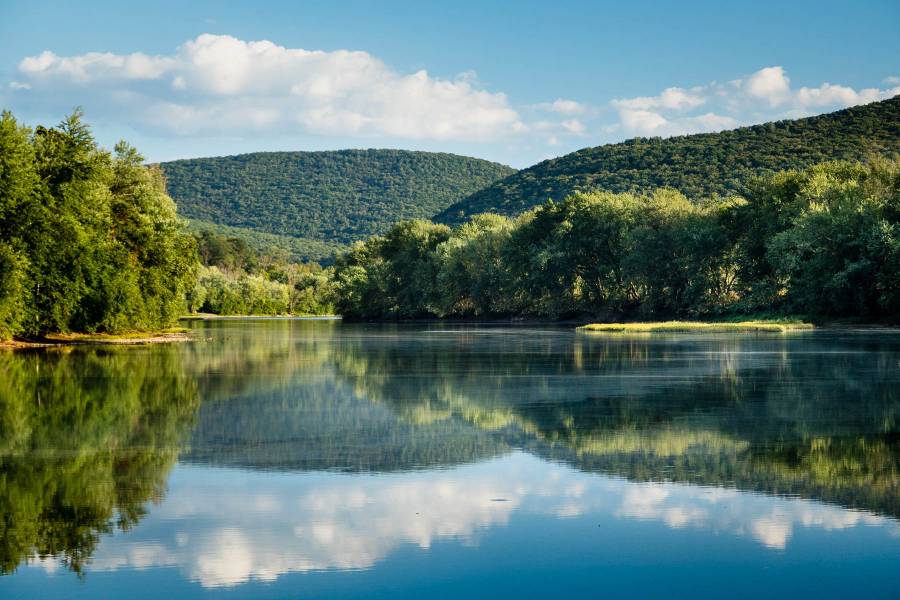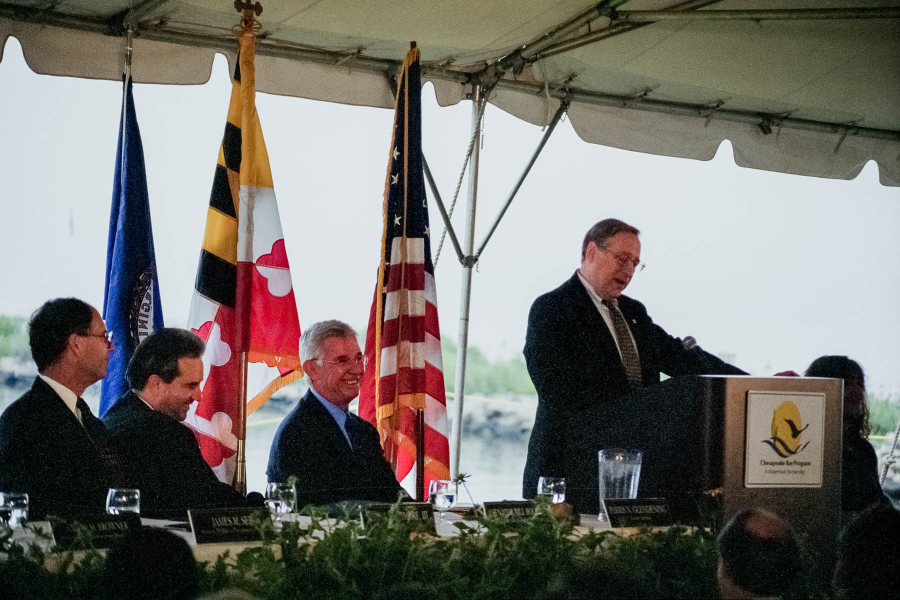Chesapeake Bay Watershed Agreement at 40: Perspectives on Pennsylvania
Past and present environmental leaders in Pennsylvania talk Chesapeake Bay restoration

On December 9, 1983, Pennsylvania became one of three states to sign the Chesapeake Bay Agreement—a document committing various partners to work towards a healthier Bay.
At the time of the signing, Pennsylvania Governor Dick Thornburgh called the Bay, “an American treasure of legendary beauty,” and noted that, “the Bay and its system of tributary rivers and streams are critically important—economically, culturally and for human health reasons.”
Jim Seif, assistant to the governor, was key to bringing Governor Thornburgh to the table. Before serving in the Thornburgh administration, Seif led the legal branch at the Environmental Protection Agency’s (EPA) Region 3 in Philadelphia. After leaving the governor’s office, he went on to head EPA Region 3 in 1985 and became the first Secretary of the Pennsylvania Department of Environmental Protection (DEP) in 1995.
In the below interview, Seif chats with Jill Whitcomb, the director of the Bureau of Watershed Restoration and Nonpoint Source Management at Pennsylvania’s DEP. Whitcomb has almost 15 years of experience in nonpoint source pollution and agriculture conservation. She’s worked at the DEP for eight years, beginning in the construction of stormwater and wetlands programs and then serving as Director of the DEP Chesapeake Bay Office from 2019-2022.
As Pennsylvania ramps up work in all or part of 43 counties to improve the health of its section of the watershed and the Bay, Jim and Jill talk about how the past informs the present.

JILL: Jim, you and Governor Thornburgh were western Pennsylvania natives. How did you come to care about the Chesapeake Bay watershed and raise the visibility of Pennsylvania’s part of the watershed?
JIM: Governor Thornburgh was aware of the Bay issue, of course. He was also an admirer of fellow Republican Charles Mathias, the U.S. Senator for Maryland, who championed the 1975 Congressional study of the Bay that led to the 1983 agreement. In my previous work at EPA Region 3 in Philadelphia, I was increasingly immersed in Bay issues, so I was able to bring the governor a lot of information that showed how Pennsylvania was truly involved.
Governor Thornburgh realized that Pennsylvania belonged to something outside the state, that the watershed is bigger than state boundaries. His sense of leadership was that Pennsylvania stepped up to the plate on these things. He understood that his signature on the Bay Agreement was a strong signal for Pennsylvania’s stewardship of the Chesapeake Bay watershed.
JILL: The Environmental Stewardship Fund, which was signed into law in 1999 by Governor Tom Ridge and funds the Growing Greener grant program, is one of the most meaningful investments in Pennsylvania’s natural resources. What was your vision for it?
JIM: Growing Greener is all about watersheds. That means watersheds of any size—from the Chesapeake Bay to the unnamed tributary in your neighborhood. We wanted people to realize their watershed is their environmental neighborhood and to foster the growth of organizations and projects so that people could take ownership.
We also wanted Growing Greener to embody the idea that just as a state funds schools, highways and social programs, it has to fund its watershed protection. Watershed quality should be a regular component of every state budget.
JIM: I worked to keep conservation districts in an environmental role as well as an agricultural one. They understand water, conservation, local action. They’re trusted local partners. To what extent are conservation districts playing a role in the watershed today?
JILL: Pennsylvania couldn’t meet its watershed goals without the conservation districts. They play a central role. For example, Pennsylvania’s Nutrient Management Act was one of the first in the nation, and conservation districts partner with the State Conservation Commission and the DEP to implement the program effectively. We use state and federal funding to support technicians and other positions at conservation districts, but we rely on them so much we’re really stretching their resources.
That’s why the DEP has worked very hard and successfully to extend our partnerships to county planning commissions, private industry and other local, state and federal leaders. In Pennsylvania’s part of the Chesapeake Bay watershed, we’ve done this through the Countywide Action Plan framework.

JILL: As DEP Secretary in the 1990s, how did you help staff understand how their work fit into the watershed?
JIM: I told them my job was to create the conditions outside the department to foster the success of DEP programs—get a good budget, reduce legislative obstructions, lobby for federal funds and increase public awareness. Once we weren’t always needing to play defense, DEP programs could be nurtured on their merits. The purpose was to help create a favorable environment for our permit writers, our water samplers, all DEP staff, to do their work and to make them feel proud of their achievements.
I like to tell the story of the stonecutter who, when asked what he’s doing, doesn’t say he’s chiseling a stone into a certain shape, but instead says, “We’re building a cathedral.” Our people have a degree of humility, but the fact is, they’re engaged in terribly important work for our economy and society. When it comes to a healthy watershed, DEP staff are the stonecutters, building the cathedral.
JIM: There’s been a lot of media attention around Pennsylvania not meeting its goals, not doing enough. What do you want critics to know?
JILL: Pennsylvania has a long history of environmental protection. Our state Clean Streams Law has been in place since 1937. Pennsylvania has had laws and regulations in place since the 1960s to ensure that mining sites are reclaimed and restored. We put regulations in place in the 1970s-1980s for stormwater and manure management, and to reduce agricultural erosion and sedimentation. Our state legislature led the charge to add the Environmental Rights Amendment in the Pennsylvania state constitution in 1971.
In the early 1990s, Pennsylvania was one of the first states to establish specific nutrient management planning requirements through law and regulation. We formed our flagship Environmental Stewardship Fund in the 1990s. Since the 2010s, we’ve revised regulations to ensure greater stormwater management, and erosion and sediment control, and instituted comprehensive data management and agricultural compliance assurance programs.
Every rule, regulation, policy and program has built on each other, with incremental improvements and accomplishments over time, despite increasing population and land development.
This progress isn’t widely known. But we’re getting better at sharing our success through tools like the Integrated Water Quality Report story map. It shows that from 2004 to 2022, the DEP has restored approximately 920 miles of streams and 28,000 acres of lakes in Pennsylvania.
JILL: You were part of two large waves in Chesapeake Bay watershed history—at the beginning, when the Agreement was signed in 1983, and again when the Environmental Stewardship Fund was established in the late 1990s and early 2000s. I think we’re at another inflection point today, with the new state Clean Streams Fund and federal funding coming. What advice do you have for partners in Pennsylvania to make the most of this moment?
JIM: I agree a third wave is upon us. We’ve known since 1983 that Pennsylvania has a major role in restoring the health of its own watershed and the Bay. We’ve known since the launch of Growing Greener it’s not about jobs versus trees; it’s about Pennsylvanians taking ownership of their watershed to create a sustainable future. We’re in a third era now, with more federal and state funds, and the DEP and its many partners going forward with great resolve and momentum.
Pennsylvania doesn't have to apologize to anybody for its environmental vision and achievements. From William Penn to the state constitution Environmental Amendment in 1970 to our work today, Pennsylvanians should be proud of and draw strength from their environmental heritage.

Comments
There are no comments.
Thank you!
Your comment has been received. Before it can be published, the comment will be reviewed by our team to ensure it adheres with our rules of engagement.
Back to recent stories